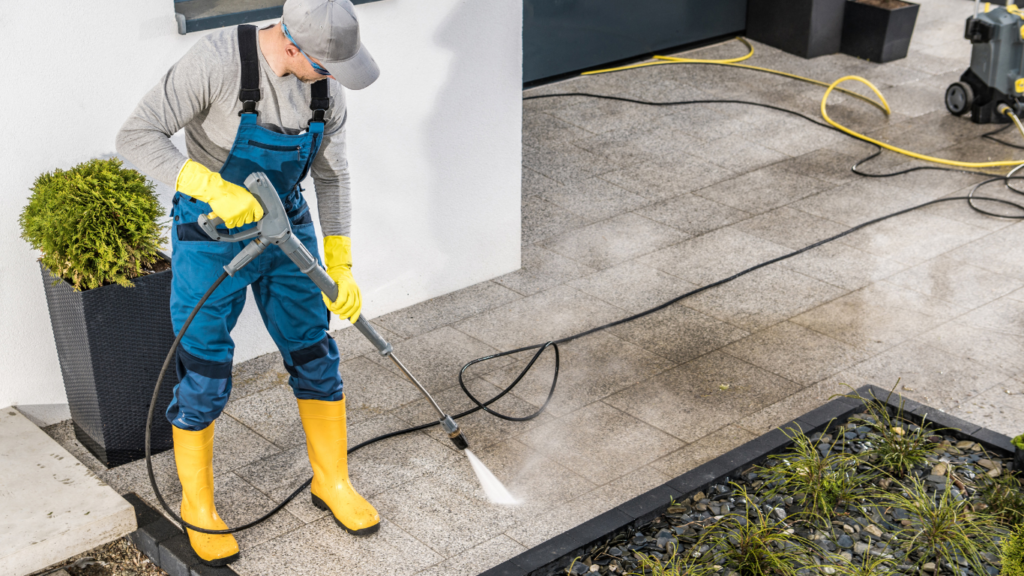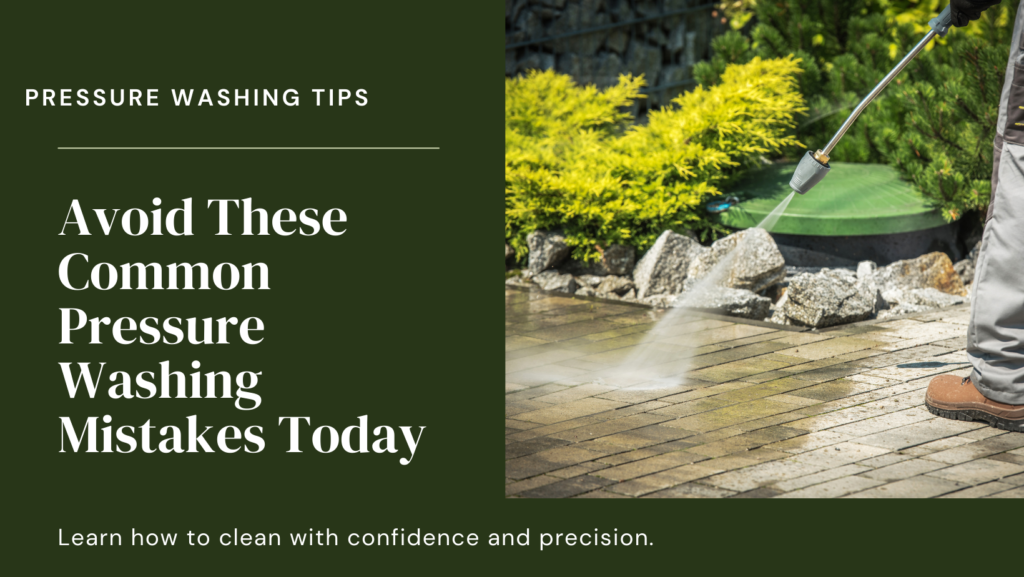Pressure washing is an incredibly effective method for cleaning various surfaces, from driveways and decks to siding and vehicles. This technique uses high-pressure water spray to remove dirt, grime, mold, mildew, and other contaminants, restoring surfaces to their original condition. However, while pressure washing can yield excellent results, it can also cause significant damage if not done correctly. In this comprehensive guide, we will delve into the common pressure washing mistakes to avoid, ensuring your cleaning projects are both safe and effective.
Understanding Pressure Washing
Definition and Purpose
Pressure washing involves using a high-pressure water spray to clean surfaces. The pressure, measured in pounds per square inch (PSI), can vary widely depending on the type of pressure washer used. This method is particularly effective for removing stubborn dirt, algae, mold, and mildew from hard surfaces such as concrete, wood, and metal. The power of pressure washing lies in its ability to clean surfaces quickly and thoroughly, making it a preferred choice for both residential and commercial cleaning tasks.
Types of Pressure Washers
Pressure washers come in various types and sizes, each designed for specific tasks. Electric pressure washers are ideal for light to medium-duty cleaning tasks. They are quieter, more environmentally friendly, and suitable for residential use. However, they typically offer lower PSI compared to gas-powered models. Gas pressure washers are more powerful and suitable for heavy-duty cleaning. These are commonly used for larger projects and commercial purposes. They provide higher PSI, making them ideal for tough cleaning tasks, but they are noisier and emit exhaust fumes.
Hot water pressure washers use heated water for more effective cleaning, especially on grease and oil stains. The combination of hot water and high pressure makes them highly effective but also more expensive and complex to operate. Cold water pressure washers are suitable for general cleaning tasks without the need for heated water. They are more common and easier to use but mayCommon Pressure Washing Mistakes to Avoid not be as effective on grease and oil stains.
Benefits of Pressure Washing
Pressure washing offers numerous benefits:
| Cleanliness | It removes dirt, mold, and mildew, significantly improving the appearance of surfaces. Regular pressure washing can maintain a clean and presentable environment. |
| Curb Appeal | Enhances the look of homes and properties, thereby increasing their value. Clean exteriors can make a property more attractive to potential buyers or tenants. |
| Maintenance | Prevents the buildup of harmful substances that can damage surfaces over time. Regular cleaning can extend the life of materials by preventing rot, decay, and premature aging. |
| Preparation for Painting or Staining | Cleans surfaces thoroughly, ensuring better adhesion of paint or stain. Proper preparation is crucial for achieving a smooth and durable finish. |
Mistakes Related to Equipment
Using the Wrong Pressure Washer
One of the most common pressure washing mistakes is using the wrong type of pressure washer for the job. Choosing the right pressure washer is crucial to avoid damaging surfaces or failing to clean effectively. Using a machine with too high PSI can strip paint, damage wood, and erode concrete. It’s important to match the PSI to the surface being cleaned. For example, delicate surfaces like wood and siding require lower PSI, while tougher surfaces like concrete can handle higher PSI. Conversely, using a machine with too low PSI may not be effective in removing tough stains and grime. This can result in the need for multiple passes, which can be time-consuming and less effective.
Incorrect Nozzle Choice
Nozzles control the angle and intensity of the water spray. Using the wrong nozzle can lead to ineffective cleaning or surface damage. Pressure washers typically come with a set of interchangeable nozzles, each designed for specific tasks. The red (0 degrees) nozzle delivers a concentrated, high-pressure stream, suitable for tough stains but can damage surfaces if not used carefully. The yellow (15 degrees) nozzle is ideal for heavy-duty cleaning, such as removing paint or tough grime. The green (25 degrees) nozzle is a general-purpose nozzle, suitable for most cleaning tasks around the home. The white (40 degrees) nozzle provides a low-pressure spray, ideal for delicate surfaces like cars, windows, and wood. The black (65 degrees) nozzle is used for applying detergents and gentle rinsing. Selecting the appropriate nozzle for the task at hand is essential to avoid common pressure washing mistakes related to equipment misuse.
Ignoring Equipment Maintenance
Regular maintenance of pressure washers ensures they operate efficiently and last longer. Neglecting maintenance can lead to equipment failure and subpar cleaning results. Checking hoses is important to inspect for leaks, cracks, or wear and tear. Damaged hoses can reduce water pressure and affect cleaning performance. Cleaning nozzles is essential to remove debris that can clog the spray and reduce effectiveness. Clogged nozzles can cause uneven water distribution and streaks on surfaces. For gas-powered washers, regular oil changes and filter replacements are essential. A well-maintained engine runs more efficiently and has a longer lifespan. Proper maintenance practices can prevent breakdowns and ensure that your pressure washer performs at its best.
Operational Mistakes
Incorrect Distance from Surface
Maintaining the correct distance from the surface is crucial for effective cleaning without causing damage. One of the most frequent pressure washing mistakes is holding the nozzle too close or too far from the surface being cleaned. Holding the nozzle too close can erode or damage the surface. High-pressure water at close range can strip paint, splinter wood, and etch concrete. Holding the nozzle too far reduces cleaning effectiveness. The water spray disperses, losing its power to remove dirt and grime effectively. Generally, maintaining a distance of 6 to 12 inches from the surface is ideal for most tasks. However, always consult the manufacturer’s guidelines for specific recommendations based on your pressure washer model and the surface being cleaned.
Inconsistent Pressure
Consistent pressure is key to achieving even cleaning results. Inconsistent pressure can result in streaks, patchy cleaning, and uneven surfaces. Maintain a steady hand and constant motion while pressure washing. Moving too quickly or too slowly can cause uneven cleaning. Ensure the pressure washer is operating correctly and that the pressure settings are appropriate for the task. Fluctuations in pressure can indicate a problem with the machine or a clogged nozzle.
Wrong Cleaning Technique
Proper technique is essential for effective cleaning and avoiding damage to surfaces. Incorrect cleaning techniques are common pressure washing mistakes that can compromise the results. Use a back-and-forth or up-and-down motion to cover the entire surface evenly. Avoid circular motions, as they can cause uneven cleaning and streaks. Slightly overlap each pass to ensure even coverage and avoid missed spots. Overlapping helps maintain consistent pressure across the surface. Holding the nozzle in one spot for too long can gouge or damage the surface. Keep the nozzle moving to prevent concentrated pressure from causing harm.
Surface-Specific Mistakes
Pressure Washing Delicate Surfaces
Delicate surfaces, such as wood, painted surfaces, and older structures, require special care to avoid damage. Use a lower PSI (500-1200) and a wider nozzle (25-40 degrees) to avoid splintering and gouging. Always follow the grain of the wood and avoid using high-pressure settings. High pressure can strip paint. Use a gentle setting and a wide nozzle to clean painted surfaces without causing damage. If paint starts to peel, stop immediately and adjust the pressure. Older buildings may have weakened materials that can be easily damaged by high pressure. Proceed with caution and use the lowest effective pressure setting. Consider testing a small area first to ensure the surface can withstand the pressure.
Not Testing a Small Area First
One of the simplest yet often overlooked steps is testing a small, inconspicuous area before full-scale cleaning. This step is crucial to avoid unintended damage. Testing a small area can reveal potential damage or adverse reactions before they become widespread problems. It allows you to see how the surface reacts to the pressure and cleaning solution. Testing also allows for adjustments in pressure, nozzle, and technique based on the test results. If the test area shows signs of damage, lower the pressure or switch to a wider nozzle. Testing a small area can save time, effort, and costly repairs by preventing extensive damage.
Environmental and Safety Mistakes
Ignoring Safety Precautions
Pressure washing can be dangerous if safety precautions are not followed. High-pressure water can cause serious injuries, and improper handling of equipment can lead to accidents. Always wear goggles, gloves, and sturdy footwear to protect against flying debris and high-pressure water. Long sleeves and pants can also help protect your skin. High-pressure water can cause lacerations, bruises, and other serious injuries. Never point the nozzle at people, pets, or yourself. Be cautious with electric pressure washers around water. Ensure that all electrical connections are dry and use GFCI (Ground Fault Circuit Interrupter) outlets to prevent electric shock.
Environmental Concerns
Improper disposal of runoff water and the use of harsh chemicals can harm the environment. Responsible pressure washing practices can mitigate these risks. Ensure that runoff water does not contaminate local water sources. Avoid pressure washing near storm drains and use containment measures to capture runoff. Use biodegradable and environmentally friendly cleaning solutions. Harsh chemicals can harm plants, animals, and water sources. Look for detergents that are labeled as safe for the environment.
Click here to learn more tips for eco-friendly pressure washing.
Neglecting Weather Conditions
Weather conditions can impact the effectiveness and safety of pressure washing. Wind can blow water and debris, reducing cleaning effectiveness. Rain can dilute detergents and make surfaces slippery, increasing the risk of accidents. Extreme temperatures can affect the cleaning process. Hot surfaces can cause water to evaporate quickly, reducing cleaning effectiveness. Cold weather can freeze water, creating hazardous conditions. Always consider the weather forecast and choose a time when conditions are optimal for pressure washing.
Preparation and Post-Wash Mistakes
Inadequate Preparation
Proper preparation ensures a thorough and safe cleaning process. One of the common pressure washing mistakes is failing to prepare the area properly. Clear the area of obstacles, furniture, and debris to provide a clear path for cleaning. Protect nearby plants and surfaces by covering them with plastic sheeting or tarps. This prevents damage from high-pressure water and cleaning solutions. Apply a pre-treatment solution to loosen dirt and grime. This makes the cleaning process more effective and reduces the need for high-pressure settings.
Skipping Post-Wash Care
Proper post-wash care is essential to maintain the cleanliness and integrity of the cleaned surfaces. Rinse surfaces thoroughly to remove any remaining detergent and debris. Leftover cleaning solutions can cause damage or discoloration. Inspect the area for any signs of damage or missed spots. Address any issues promptly to ensure a thorough cleaning. Allow surfaces to dry completely before using them or applying any finishes. Moisture can lead to mold and mildew growth, undoing the cleaning efforts.
Not Following Manufacturer Guidelines
Every pressure washer is different, and following the manufacturer’s guidelines is crucial to avoid common pressure washing mistakes. Consult the user manual for specific instructions on pressure settings, nozzle usage, and maintenance. Adhering to these guidelines ensures optimal performance and longevity of the equipment.

In conclusion, pressure washing is an effective cleaning method that can yield excellent results when done correctly. Avoiding common pressure washing mistakes, such as using the wrong equipment, improper techniques, and neglecting safety and environmental considerations, ensures a safe and successful cleaning experience. By understanding and addressing these mistakes, you can achieve a thorough, efficient, and damage-free cleaning process, enhancing the appearance and longevity of your surfaces.

